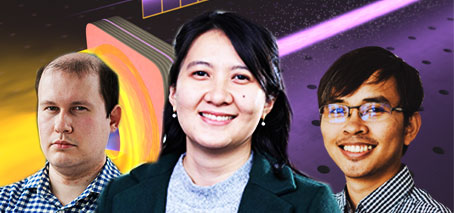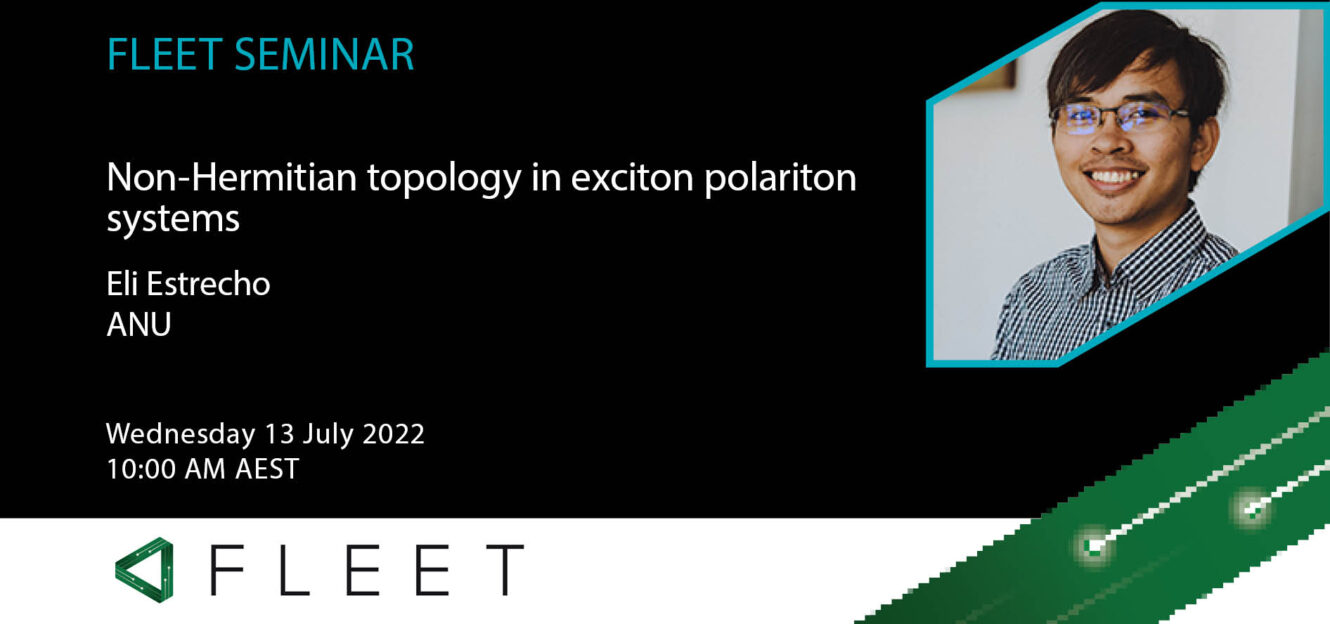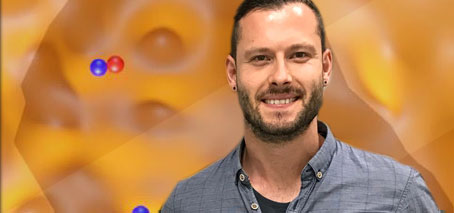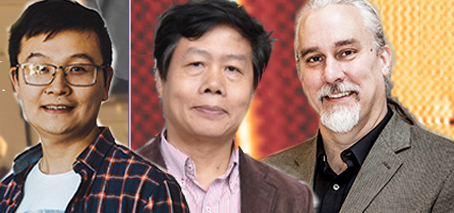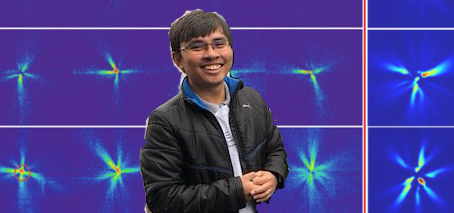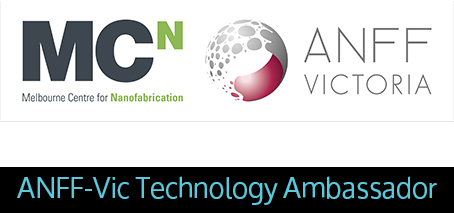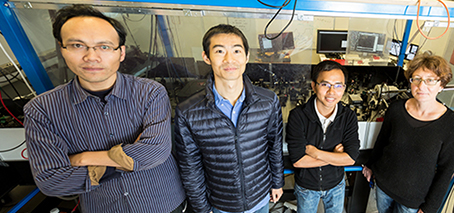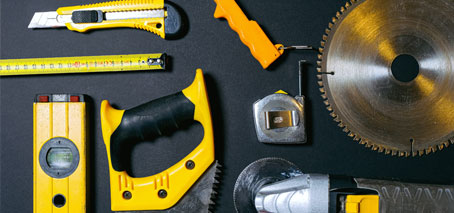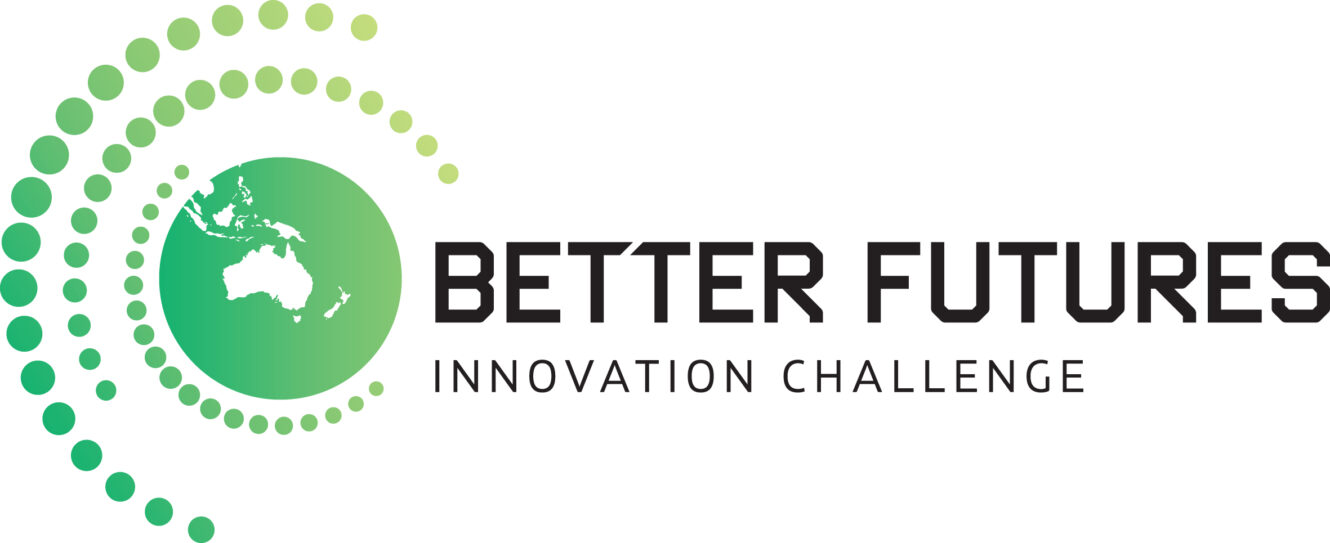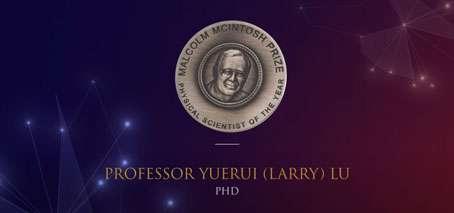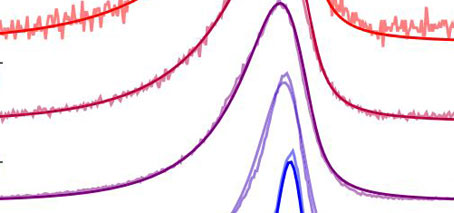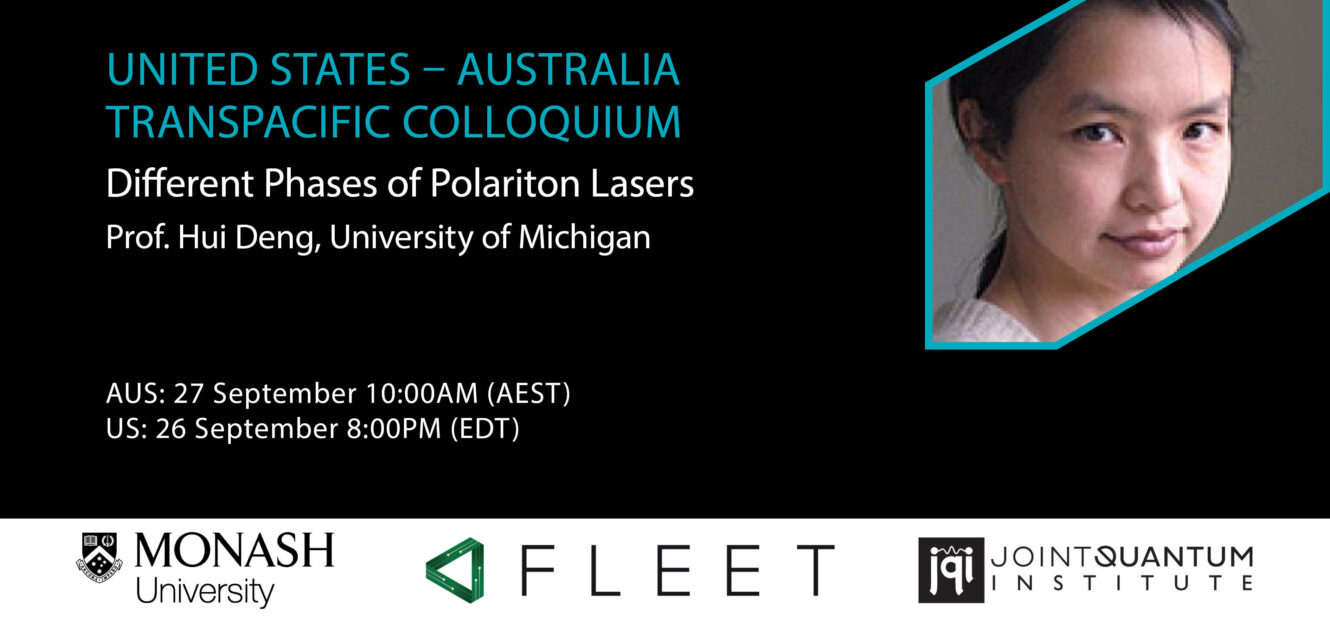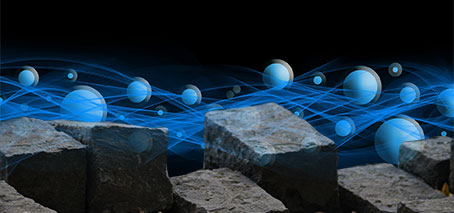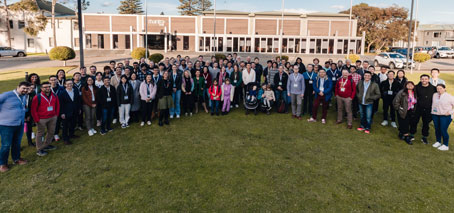Ground-breaking research revealed the ultra-narrow linewidth of a novel type of laser that operates without population inversion. Exciton-polariton lasers, renowned for their low-power operation, have long tantalised researchers with their promise for practical low-energy applications. However, until now, a clean measurement of the laser’s linewidth, or spectral purity, has remained elusive. “The spectral purity is one of the defining characteristics …
Dark excitons shed new light on matter
A team of Monash researchers have uncovered for the first time the full effects of interactions between exciton-polaritons and their associated dark excitonic reservoir. Exciton-polaritons (‘polaritons’, for short) are hybrid mixtures of light and matter that inherit the best properties of both. They form in semiconductors sandwiched between two mirrors, through which a laser is shone. “Polaritons capture useful properties …
Advancing Aus-Europe exciton physics links
The FLEET-EU 2023 Conference : Transport in exciton condensates and exciton insulators took place on September 11, 2023 in San Benedetto del Tronto, the art-deco resort town known as the Riviera of the Palms situated on the Italian Adriatic coast. The conference was jointly organised by University of Camerino (Italy), University of Antwerp (Belgium), and FLEET, and covered a range …
Multidimensional coherent spectroscopy of moiré intralayer excitons in twisted WSe2/WSe2 homobilayers
Kyle Boschen completed his Honours project in 2022 and is now undertaking a PhD in CI Jeff Davis‘ group. He is investigating the properties of two dimensional semiconducting TMDs using ultrafast spectroscopy. The project fits the FLEET Enabling Research Theme 2, Exciton Superfluids
Finding an exciton condensate in a topological insulator
Recent evidence suggests monolayer WTe2 could be an excitonic insulator. If so, carrier doping and interaction with the substrate should heavily affect the bandgap. The Bose-Einstein condensate of excitons are predicted to exhibit charge order with a characteristic momentum. When grown on an insulator as opposed to a conductor, we have observed the formation of a significantly larger (∼ 200 …
Excitons in 2D TMD in Strong Magnetic Fields
The excitonic resonances in 2D TMDs are known to be dependent on magnetic field, often described with a simplified Hamiltonian featuring a diamagnetic term quadratic in B. This simple picture is sufficient for 1s excitons in realistic laboratory conditions, however it fails to capture the behaviour of higher order excitons even at moderate magnetic field strength. In this work we …
Resonant exciton-exciton annihilation of intervalley dark excitons in atomically-thin transition metal dichalcogenides
Here, we demonstrate up-conversion photoluminescence of optically forbidden (dark) excitons in few-layer transition metal dichalcogenides. Transition metal dichalcogenides were mechanically exfoliated onto sapphire substrates using a dry transfer technique. We show that the resonance between up-converted excitons and the bright exciton state at Γ valley results in a strongly enhanced photoluminescence, evidenced by temperature, layer and excitation dependent photoluminescence measurements. …
Non-Hermitian Quantum Geometric Tensors in an Exciton-Polariton System
About the presenter Yow-Ming (Robin) Hu is a PhD student working with Chief Investigator Elena Ostrovskaya. Her project aims to characterise the topology of an exciton-polariton system and to show how to calculate and measure its quantum geometric tensor, including complex Berry curvature. This works towards a key objective of FLEET Research Theme 2 Exciton Superfluids to observe, theoretically and …
Resonant exciton-exciton annihilation of interlayer dark excitons in atomically-thin TMDs
Optical properties of dark excitons in transition metal dichalcogenides (TMDs) have been received lots of attention due to its significant role in fundamental properties of exciton physics. Here, we demonstrate up-converted photoluminescence (PL) in few-layer WSe2 through exciton-exciton annihilation of intervalley dark excitons. WSe2 was mechanically exfoliated onto silicon substrates with 285-nm-thick SiO2 using a dry transfer technique. We performed …
Reservoir-induced linewidth broadening of exciton-polariton laser
About the presenter Bianca is a PhD candidate in CI Elena Ostrovskaya‘s group. Her project aims to realise, experimentally, exciton polaritons in artificial lattices and observe novel topologically protected states. This work fits the FLEET Enabling Research Theme 2, Exciton Superfluids.
Quantifying exciton interactions strength and charge transfer rates in TMDC heterostructures
Polaron-polariton in a dark excitonic medium
About the presenter Kenneth is a PhD candidate in CI Meera Parish‘s group. His research aims to investigate the interactions between excitons (or exciton-polaritons), and 2-D electron gas, with a view to inducing a collective, dissipationless flow of charged bosons: exciton-mediated superconductivity.
Exciton polaritons
About the presenter Dr Eliezer Estrecho is a DECRA Fellow at the Australian National University and a Research Fellow of FLEET. His research interests are mainly on exciton-polariton condensates, non-Hermitian physics, and strong light-matter interaction, specifically between electronic excitations (excitons) and photonic modes.
Efficient exciton-exciton annihilation of dark excitons in atomically-thin TMDs
Optical properties of dark excitons in transition metal dichalcogenides (TMDs) have been received lots of attention due to its significant role in fundamental properties of exciton physics. Here, we demonstrate up-converted photoluminescence (PL) in n-layer WSe2 (n > 2) through exciton-exciton annihilation of dark excitons. Few-layer WSe2 were mechanically exfoliated onto silicon substrates with 285-nm-thick SiO2 using a dry transfer …
Effects of Floquet engineering on the coherent exciton dynamics in monolayer WS2
Using light to control non-equilibrium phenomena in quantum systems is at the forefront of condensed matter research. Here we utilise MDCS to create an inter-valley coherence in monolayer WS2 and measure the pump induced changes to the coherent exciton dynamics. About the presenter Mitchell Conway is a Research Fellow at Swinburne University with CI Jeff Davis. He just completed his …
Finding an exciton condensate in a topological insulator
Recent evidence suggests monolayer WTe2 could be an excitonic insulator. While this theory is controversial, if correct, the excitonic condensate should exhibit a charge density wave (CDW) and should collapse with electron doping. Through scanning tunnelling microscopy (STM) and angle-resolved photoelectron spectroscopy (ARPES) we display evidence of these phenomena and are making progress toward confirming their excitonic nature with theoretical …
Time evolution of spatial coherence in exciton-polariton condensates
Exciton-polaritons (polaritons herein) are bosonic quasiparticles formed when an exciton is coupled to a cavity photon in a semiconductor microcavity [1]. These hybrid light-matter quasiparticles form Bose-Einstein condensates at elevated temperatures due to their very small effective mass. However, polariton condensates are inherently non-equilibrium because of the ultrashort lifetime of polaritons and coexistence with a reservoir of high-energy excitons feeding …
Efficient brightening of dark excitons in InSe atomic layers
Atomically-thin InSe exhibited strong PL emission from its dark excitons due to efficient acoustic-phonon-exciton coupling, resulting in high population density and efficient radiative recombination. The asymmetric lineshape observed in the PL emission is explained by the carrier localization model, attributed to nonuniform surface potentials. About the presenter Shao-Yu Chen is a Scientific Associate Investigator from the National Taiwan University, collaborating …
Microscopy theory of excitons bound by light
We investigate the formation of excitons bound by photons using a microscopic Hamiltonian involving quantum well electrons, holes, and microcavity photons. The negative reduced effective mass of the quantum well electron-hole (e-h) pair prevents Coulomb bound excitonic states, but the microcavity photon is capable of inducing binding. Using a theory based on Green’s functions we have calculated the spectral response …
Polaritons in an excitonic reservoir
We investigate interactions between polaritons and a dark excitonic reservoir in a 2D system where the excitons are tightly-bound. The resulting energy spectrum is found to display several interesting features, including the appearance of a new energy mode related to a biexcitonic bound state, an apparent reduction in the Rabi splitting between the lower and upper polariton branches as the …
Effects of Floquet Engineering on the Coherent Exciton Dynamics in Monolayer WS2
Bandgap and Exciton Energy Renormalization in Doped TMD
About the presenter Jack is a PhD candidate in CI Oleg Sushkov‘s group. His project aims to establish a theoretical groundwork for magnetohydrodynamics in 2D electron fluids using periodic micromagnets. This work fits the FLEET Enabling Research Theme 1, Topological Materials.
Wave packet dynamics and emergent topological defect in non-Hermitian exciton polaritons
About the presenter Yow-Ming (Robin) Hu is an Honours student working with Chief Investigator Elena Ostrovskaya. Her project aims to characterise the topology of an exciton-polariton system and to show how to calculate and measure its quantum geometric tensor, including complex Berry curvature. This works towards a key objective of FLEET Research Theme 2 Exciton Superfluids to observe, theoretically and …
Rapid exciton diffusion in non-fullerene acceptors and its implications for OPV device architectures and computational materials screening
About the presenter Prof Justin Hodgkiss uses ultrafast optical spectroscopy at the Victoria University of Wellington in search of molecular electronic materials for new, low-cost printable electronics – primarily solar cells. His group invented transient grating ultrafast fluorescence spectroscopy and has used laser spectroscopy to develop a detailed understanding of the physics of photocurrent generation in printable solar cells. Prof …
Spatially indirect exciton condensates
About the presenter Prof Francois Peeters is a member of FLEET’s International Scientific Advisory Committee. He leads the Condensed Matter Theory Group at the University of Antwerp and also distinguished Professor at Yunnan University. Prof Peeters has made seminal contributions in areas of meso- and nano-physics of semiconductors, two dimensional materials and superconductors. Currently, his interest is in two-dimensional atomic …
Polaritons in an excitonic reservoir
About the presenter Kenneth is a PhD candidate in CI Meera Parish‘s group. His research aims to investigate the interactions between excitons (or exciton-polaritons), and 2-D electron gas, with a view to inducing a collective, dissipationless flow of charged bosons: exciton-mediated superconductivity.
FLEET Seminar: Yuerui Larry Lu – Enhanced Interactions of Interlayer Excitons in Free-standing Hetero-bilayers
Prof. Yuerui (Larry) Lu, School of Engineering, Australian National University (ANU) Missed the seminar? Catch up on FLEET’s YouTube. Abstract Strong, long-range dipole-dipole interactions between interlayer excitons (IXs) can lead to novel multi-particle correlation regimes that drive the system into distinct quantum and classical phases including dipolar liquids, crystals, and superfluids. Both repulsive and attractive dipole-dipole interactions have been theoretically …
FLEET seminar – Non-Hermitian topology in exciton polariton systems
Dr Eli Estrecho, FLEET research Fellow, Polariton BEC Group, Australian National University Missed the talk? Catch-up on YouTube Losses are known to be detrimental to devices but judiciously controlling them can lead to counterintuitive gains. For example, by increasing loss, lossy materials can become transparent or a lossy laser can turn on again. In this seminar, I will discuss our …
FLEET seminar: Exciton condensation in bilayer graphene
Dr Harley Scammell, UNSW Missed the talk? Catch up on YouTube By analogy with BCS superconductivity, it has long been expected that excitons condense in (nearly) particle-hole symmetric two-dimensional semimetals. However, in the absence of a magnetic field, very few examples are known. And I will not be providing one. Instead, I will propose an alternate route to exciton condensation. …
FLEET seminar. Properties and dynamics of exciton polaritons in atomically-thin WS2 crystals at room temperature
Matthias Wurdack, FLEET Research Fellow, Australian National University Monolayer transition metal dichalcogenide crystals (TMDCs) hold great promise for semiconductor optoelectronics because their bound electron-hole pairs (excitons) are stable at room temperature and interact strongly with light. When TMDCs are embedded in an optical microcavity, their excitons can hybridise with cavity photons to form exciton polaritons (polaritons herein), which could be …
Bonding exercise: quantifying biexciton binding energy
Two-quantum multidimensional coherent spectroscopy (2Q-MDCS) quantifies precise biexciton binding energy Applications in future devices based on biexcitons in TMDCs A rare spectroscopy technique performed at Swinburne University of Technology directly quantifies the energy required to bind two excitons together, providing for the first time a direct measurement of the biexciton binding energy in WS2. As well as improving our fundamental …
FLEET Schools: The Exciton-Polariton
Sandwich-style construction: towards ultra-low-energy exciton electronics
New microcavity construction technique allows observation of robust, room-temperature exciton transport Polariton performance optimised by maximising photon-exciton energy exchange, minimizing the damage to monolayer A new ‘sandwich-style’ fabrication process placing a semiconductor only one atom thin between two mirrors has allowed Australian researchers to make a significant step towards ultra-low energy electronics based on the light-matter hybrid particles exciton-polaritons. The …
Honours Project: Excitonic superfluidity in electron-hole bilayers
Superconductivity and superfluidity are macroscopic quantum phenomena that are observed at low temperatures. Bringing them to room temperatures is the Holy Grail in physics. One prospective system is a double layered semiconductor structure with spatially separated electrons and holes (holes are empty electronic states that can be treated as particles with positive charges). Attractive Coulomb interactions can bind them to …
Exploring non-Hermitian physics with exciton polaritons
Prof Elena Ostrovskaya Australian National University the Research School of Physics, the Australian National University Exciton polaritons are hybrid light-matter bosons formed by excitons in semiconductors strongly coupled to microcavity photons. Sufficiently strong optical pumping can drive exciton-polaritons to a macroscopically occupied coherent state similar to a Bose-Einstein condensate. The same optical pump that injects polaritons into the system and …
Invited: Exciton-polaritons and exciton-polariton lattices
About the presenter PI Prof Sven Höfling oversees the design and fabrication of highly customised semiconductor samples for Research Theme 2 on exciton and exciton-polariton systems, as well as contribute his extensive expertise in all aspects of exciton-polariton physics.
Long-lived populations of momentum- and spin-indirect excitons in monolayer WSe2
In monolayer WSe2, the ground-state exciton is dark (D exciton, spin-indirect), and the valley degeneracy allows low-energy dark momentum-indirect excitons (XK exciton) to form. Interactions between the dark excitons and the optically accessible bright exciton (X) are likely to determine X exciton’s optical properties at high power and limit the ultimate exciton densities be achieved. However, so far, little is …
Interactions and correlations in exciton-polariton systems
I will give an update on recent theoretical progress in understanding the nature of interactions in exciton-polariton systems. About the presenter CI A/Prof Meera Parish develops many-body theories that span electron-hole systems and ultracold atomic gases. In Research Theme 2, she is investigating the fundamental properties of exciton-polariton condensates, while in Research Theme 3, she is studying quantum systems out of …
Coherent dynamics and excitation density dependence in exciton-polaritons system
About the presenter Tatek Lemma is a PhD student working with CI Jeff Davis in FLEET’s Research Theme 3 and in Research theme 2. For his PhD, he is working on the investigation of topological phase transition in a 2D semiconductor using the state-of-the-art Coherent multidimensional spectroscopy.
Towards long-lifetime excitons in 2D semiconductors
About the presenter Daniel McEwen is an Honours student working with CI Michael Fuhrer at Monash University.
Ultrafast Exciton-Polariton Dynamics in Microcavity Structures
About the presenter Mitko Oldfield is an experimental physicist specialising in terahertz time-domain spectroscopy and exciton-polariton condensation, working with Dr Agustin Schiffrin and Dr Gary Beane at Monash University within FLEET’s research theme 2 and research theme 3. Mikto’s research focuses on forming a polariton condensate in high Q-factor microcavities through the use of a terahertz pumping beam generated via …
Measurement of the non-Hermitian topological invariant in perovskite-based exciton polaritons
About the presenter Eliezer Estrecho studies the behaviour of exciton-polaritons as part of FLEET’s research theme 2, exciton superfluids, working with Elena Ostrovskaya at the ANU. He is currently studying condensation of polaritons in gallium-arsenide-based microcavities using single-shot experiments and large optically induced traps. He is also working on creating polariton condensates using atomically-thin materials.
FLEET Seminar: Nina Voronova – Quantum hydrodynamics of cold exciton gases and ultrafast Rabi-oscillating vortices in exciton-polariton condensates
Dr Nina Voronova National Research Nuclear University, Moscow Engineering Physics Institute All welcome. Download seminar flyer here. Abstract: Excitons and exciton-polaritons are bosonic quasiparticles that can demonstrate high degree of spatial coherence and quantum properties, and at the same time the ability to propagate on macroscopic distances, thus presenting a perfect solid-state platform for studying many-body effects. On top of …
Experimental observation of a new class of materials: excitonic insulators
First observation of excitonic insulator New exotic state was first predicted in 1960s A University of Wollongong / Monash University collaboration has found evidence of a new phase of matter predicted in the 1960s: the excitonic insulator. The unique signatures of an excitonic insulating phase were observed in antimony Sb(110) nanoflakes. The findings provide a novel strategy to search for …
First snapshot of exciton-polariton condensation process
First snapshot of exciton-polariton Bose-Einstein condensation (BEC) in an inorganic semiconductor Unique opportunity to understand details of BEC without statistical averaging Key to fundamental understanding of exciton-polaritons An ANU advance provides never-before-achieved ‘snapshot’ of Bose-Einstein condensation. Previously, observations of exciton-polaritons in a Bose-Einstein condensate were limited to statistical averaging over millions of condensation events. ‘Snapshot’ imaging of polaritons forming a …
MCN Tech Ops Seminar: Bose-Einstein Condensation of exciton-polaritons in 2D materials
Bose-Einstein Condensation of exciton-polaritons in 2D Mterials Tinghe Yun Monash University All welcome! Abstract: The project is aiming at the excitonic dissipationless system, towards the room temperature superfluidity. Bose-Einstein condensation (BEC), which is the physical phenomena of bosonic particle coherence, is regarded as the typical superfluidy. Exciton-polaritons, the result of strong coupling between photon and exciton, is a kind of …
Exciton superfluids
Chiral flow: twisting exciton-polariton condensates at exceptional points
Outstanding problem in exciton-polariton physics resolved using exceptional points at ANU Chirality of mode at EP opens future research avenues for exciton-polariton physics Researchers at ANU recently proved a novel method for generating orbital angular momentum states (vortices), with a topological charge that is ensured by an exceptional point. Recent studies at the ANU resolve an outstanding problem in exciton-polariton …
Puzzling results explained: a multiband approach to Coulomb drag and indirect excitons
Taking a multiband approach explains ‘electron-hole reverse drag’ and exciton formation Mystifying experimental results obtained independently by two research groups in the USA seemed to show coupled holes and electrons moving in the opposite direction to theory. Now, a new theoretical study has explained the previously mysterious result, by showing that this apparently contradictory phenomenon is associated with the bandgap …
Monash: Indirect excitons and exciton-polaritons in 2D heterostructures
Application close 18 February 2018 We seek an experimental physicist or materials scientist with expertise in van der Waals heterostructures of atomically thin materials, nanofabrication techniques, and electrical and/or optical measurements. The fellow will fabricate and characterise novel atomically thin semiconductor heterostructures for the observation of exciton and exciton-polariton condensation. The fellow will be working with Prof Michael Fuhrer at …
ANU: Exciton polaritons in atomically thin materials – 2 Level B/C positions
Applications close 31 Dec 2017. We are seeking two Level A/B Academic positions in experimental physics of exciton polaritons. The Research Fellows will take primary responsibility for the construction and maintenance of the experimental apparatus and daily operation of the laboratory. The candidates will be expected to have an in-depth experience in experimental exciton-polariton physics, spectroscopic experiments with semiconductor microcavities, and time-resolved …
Research in Exciton Superfluids
FLEET researchers undertake various research projects in the area of Exciton Superfluids. If you have a project that would fit this theme, find information about a potential supervisor here: A/PROF. MEERA PARISH Theory of strongly correlated phenomena in ultracold atomic gases and electron systems Superconductivity and superfluidity Lowdimensional systems Magnetotransport A/PROF. QIAOLIANG BAO Atomically thin optical materials (graphene, 2D transition …
ANU: Exciton polaritons in 2D atomically thin materials
Supervisors: A/Prof. Elena Ostrovskaya and A/Prof. Andrew Truscott Atomically thin transition metal dichalcogenides represent a perfect 2D “flatland” platform for creating excitons with large binding energies and coupling them to light. Strong coupling to light and formation of exciton polaritons in open and monolythic microcavities has been very recently reported by several groups around the world. This project will aim …
ANU: Non-equilibrium quantum condensation of microcavity exciton polaritons
Supervisors: A/Prof. Elena Ostrovskaya and A/Prof. Andrew Truscott Exciton polaritons are bosonic composite particles that are part light and part matter. They are composed of photons and excitons (electron/hole pairs) forming in semiconductor microcavities in the strong light-matter interaction regime. Akin to ultracold neutral bosonic atoms, polaritons can undergo Bose-Einstein condensation. In a Bose-Einstein condensate (BEC), millions of bosons occupy …
Exciton superfluids
DIY science-comms, results
At FLEET, we have put significant work into helping scientists develop communication skills (see the case study) and over FLEET’s seven year tenure we published many stories written by FLEET researchers. In most cases, these are stories aimed at a more technical audience, for example published on platforms such as Phys.org, or Materials Australia magazine. While such articles are certainly …
FLEET News
FLEET News in June 2024 was the final edition of the regular monthly newsletter and included FLEET landing event, ways for members and affiliates to stay in touch (Friends of FLEET), upcoming conferences and more. Unfortunately, with the old FLEET website having been archived, you’ll find that internal story links inside the newsletters will no longer work. To repair them, …
FLEET Landing celebrates Centre achievements
Around 140 FLEET members, friends and partners gathered at Monash this week at the FLEET Headquarters to celebrate the Centre’s achievements. Funded in 2017, FLEET was officially launched at the same venue, Monash New Horizons Centre, on 12 June 2018. Guests include current members, alumni, collaborators and stakeholders, all of whom have contributed and supported FLEET in its seven-year journey. …
FINESS2024 Finite temperature non-equilibrium superfluid systems
Present your work at FINESS The FINESS workshop series aims to bring together a critical mass of theoretical and experimental expertise at the forefront of research in the fields of degenerate ultra-cold matter, polariton-exciton condensates, as well as strongly correlated and open quantum systems. The central aims of FINESS are: To seed the development of theoretical approaches for finite-temperature non-equilibrium …
Surfaces on the move: dynamic liquefaction
The boundary between solid metal and liquid metal can be much less ‘solid’ than we ever suspected. RMIT researchers have discovered that the liquid-solid boundary can fluctuate back and forth, with metallic atoms near the surface breaking free from their crystal lattice. Observing a metal-alloy mass solidifying in a sea of liquid metal, the team was able to observe a …
Better Futures Industry Challenge 2024
Faster ways to respond to emergencies and ultra-sensitive quantum seismometers for earlier detection of earthquakes, were two ideas that emerged from teams of intrepid researchers from five Centres of Excellence who competed in the inaugural Better Futures Innovation Challenge to solve critical industry problems. Industry partners for the deep-tech hackathon had access to researcher skills spanning the fields of physics, …
inSTEM 2023 : addressing disability, chronic illness & mental ill-health
The second inSTEM conference took place in Melbourne, 19–21 September 2023, at RMIT’s iconic Storey Hall. (Story by EQUS Communications & Engagement Manager, Dr Kristen Harley) inSTEM is a networking and career development conference for people from marginalised or underrepresented groups in STEM, and their allies. Originally developed by ARC Centre of Excellence for Engineered Quantum Systems (EQUS)’ EQUIP committee, …
Better Futures Innovation Challenge hackathon event
A Science Meets Industry Hackathon Five of Australia’s ARC Centres of Excellence, EQUS, Exciton Science, OzGrav, TMOS and FLEET have joined forces to launch the Better Futures Innovation Challenge – A Science Meets Industry Hackathon! We are a collective of Australia’s brightest research minds, bringing together innovative ideas, skills and people. Our mission is to develop new collaborations with the Australian …
Variations of the interactions between Fermi-polarons in 2D WS 2 with doping density
Trion resonance in polariton-electron scattering
Strong interactions between charges and light-matter coupled quasiparticles offer an intriguing prospect with applications from optoelectronics to light-induced superconductivity. Here, we investigate how the interactions between electrons and exciton-polaritons in a two-dimensional semiconductor microcavity can be resonantly enhanced due to a strong coupling to a trion, i.e., an electron-exciton bound state. We develop a microscopic theory that uses a strongly …
Probing proximity in topological insulator / magnetic insulator heterostructures
Magnetic proximity between topological insulators and magnetic insulators is expected to yield interesting states such as the quantum anomalous Hall insulator or axion insulator. In this work, we demonstrate progress towards the creation and characterisation of such structures through transferred MBE TI growths onto MIs, or direct growths on MIs. About the presenter Matthew Gebert is a PhD student in …
ARC Discovery funding
This month’s ARC Discovery Project announcement saw FLEET research and researchers awarded additional research funding for ten projects building fundamental knowledge and strengthening Australia’s quantum, photonics and nanotechnology ecosystems. See the Australian Research Council media release. Dimitrie Culcer (UNSW); Allan MacDonald. Filling a substantial knowledge gap in novel semiconductors that can function as sensors in a frequency range where conventional …
Superfluid flow in channels
A superfluid transistor requires flow through a potentially disordered channel. This poster will provide an overview of research at UQ on the nonequilibrium flow of superfluids through two-dimensional channels. About the presenter CI Prof Matthew Davis makes use of the methods of reservoirs and open quantum systems to drive transitions between novel nonequilibrium states of matter, and his work focuses …
Measuring Polariton-Polariton Interactions Via Ultrafast Spectroscopy
About the presenter Matthew Berkman is an Honours student working with CI Jeff Davis at Swinburne. His project is focusing on measuring polariton interactions with multidimensional coherent spectroscopy. Specifically, he’s quantifying the complex valued interaction strength between polaritons (in GaAs system) as a function of exciton fraction and for same and opposite spin polaritons
Strong light-matter coupling in open microcavities
About the presenter Mateusz is a Research Fellow in CI Elena Ostrovskaya‘s group. He received his PhD at the University of Warsaw in Poland where he worked on microcavities filled with liquid crystals. His work fits the FLEET Research Theme 2, Exciton Superfluids.
Resonant skew scattering of plasmons
The electron skew scattering by impurities is one of the major mechanisms causing the anomalous Hall effects in semiconductor nanostructures. In this Letter, we argue that in plasmonic setups the skew scattering of plasma waves can be engineered to be giant and observed directly via near-field probes. In particular, we consider the scattering of plasma waves in gated two-dimensional electron …
Optical Pump Terahertz Probe
Overview of recent exciting results on room temperature condensation of exciton-polaritons and Optical Pump Terahertz Probe (OPTP) results in graphene. About the presenter Gary Beane is a Research Fellow working with A/Prof Agustin Schiffrin at Monash University, where he is investigating optically driven topological phases of matter using terahertz time domain spectroscopy and ultrafast pump-probe spectroscopy. He is mainly involved …
Non-Onsager quantum magnetic oscillations
A long standing puzzle has been resolved… About the presenter CI Prof Oleg Sushkov leads two theoretical investigations within Research Theme 1: (i) Artificial nanofabricated materials including artificial topological insulators. (ii) Laterally modulated oxide interfaces. Within Research Theme 3 Sushkov also participates in studies of theoretical many-body physics aspects of exciton condensates and cold atoms aimed at support of the …
Dynamic Equilibria for the Solid Metal – Liquid Metal Interface
Liquid metal alloys are an ever growing industry with a myriad of potential applications such as catalysis, and electronics.1 Unfortunately, the full potential of these materials are under-utilised and is outside the scope of other research parameters.2 Herein, nanodroplet alloyed materials are probed and investigated with the use of a Transmission Electron Microscope (TEM), thus unlocking the potential these materials …
Liquid metals: an ideal platform for the synthesis of two-dimensional materials
The surfaces of liquid metals can serve as a platform to synthesise two-dimensional materials. By exploiting the self-limiting Cabrera-Mott oxidation reaction that takes place at the surface of liquid metals exposed to ambient air, an ultrathin oxide layer can be synthesised and isolated. Several synthesis approaches based on this phenomenon have been developed in recent years, resulting in a diverse …
Overview of THz-TDS results
I will present on recent results in our group on 1) room temperature condensation of exciton-polaritons in perovskite-DBR microcavities and 2) Broadband optical-pump THz probe (OPTP) results with graphene. About the presenter Gary Beane is a Research Fellow working with A/Prof Agustin Schiffrin at Monash University, where he is investigating optically driven topological phases of matter using terahertz time domain …
Rabi oscillations and magnetization of a mobile spin-1/2 impurity in a Fermi sea
About the presenter Brendan is working with CI Meera Parish to investigate the dynamics of excitons in two-dimensional semiconductors, with a particular focus on spectroscopic probes and the effect of electron doping or large carrier densities. to characterise the topology of an exciton-polariton system and to show how to calculate and measure its quantum geometric tensor (including complex Berry curvature). …
Robust, low-threshold polariton condensates in spin-coated perovskite microcavities
About the presenter Mitko Oldfield is an experimental physicist specialising in terahertz time-domain spectroscopy and exciton-polariton condensation, working with A/Prof Agustin Schiffrin and Dr Gary Beane at Monash University within FLEET’s research theme 2 and research theme 3. Mikto’s research focuses on forming a polariton condensate in high Q-factor microcavities through the use of a terahertz pumping beam generated via …
FLEET Legacy Workshop Program
The scientific program is below, the abstract and presenter bio can be viewed by clicking on the title. The PDF of the workshop schedule can be downloaded here. Venue map Breakfast and Lunch: Novotel restaurant Registration and tea breaks: Pre-function lobby Conference: Surfers|Currumbin Poster sessions: Miami|Wavebreak Dinner: Surfers|Currumbin Creche: Kirra Executive meeting on Thursday: Burleigh Wednesday 29 Nov 2023 Poster …
Yuerui (Larry) Lu wins Malcolm McIntosh Prize for Physical Scientist of the Year
Congratulations to Prof Yuerui Larry Lu (ANU), receiving the 2023 Malcolm McIntosh Prize for Physical Scientist of the Year—recognising his work in interlayer exciton pairs, paving the way for faster, more energy-efficient future electronics. Professor Lu was recognised for discovering interlayer exciton pairs, which can help to unravel the phenomenon of superfluidity. This discovery is paving the way for new …
Solving quantum mysteries: New insights into 2D semiconductor physics
Researchers from Monash University have unlocked fresh insights into the behaviour of quantum impurities within materials. The new, international theoretical study introduces a novel approach known as the ‘quantum virial expansion,’ offering a powerful tool to uncover the complex quantum interactions in two-dimensional semiconductors. This breakthrough holds potential to reshape our understanding of complex quantum systems and unlock exciting future …
UNSW-FLEET seminar. Electronic properties of monolayer transition metal ditellurides
Dr Iolanda Di Bernardo, Marie Sklodowska-Curie Fellow at IMDEA Nanociencia; Associate investigator at ARC FLEET Centre of Excellence; School of Physics and Astronomy, Monash University In person – Venue: G59, K15 Old Main Building, UNSW On Zoom Transition metal ditelluride (TMDT) monolayers are of considerable interest for fundamental research as they present strongly electron-correlated phases, including charge density waves and …
Terahertz frequency switching in graphene
A Meet FLEET innovation-and-industry event poster The Challenge The International Energy Agency (IEA) has identified computing, and in particular data centres, as a rising source of energy usage. Energy generation continues to be dominated by the burning of fossil fuels such as gas, coal and oil – all of which produce carbon dioxide (CO2 ), which contributes to the Greenhouse …
Different Phases of Polariton Lasers
Prof. Hui Deng, Professor in Physics, Applied Physics and Electrical Engineering, University of Michigan Missed the presentation? Catch up on FLEET’s YouTube channel Non-equilibrium systems can exhibit new types of phase transitions not found in equilibrium ones, such as spontaneous pattern formation and phase separation. An interesting platform for studying such phenomena is the exciton-polaritons in semiconductor micro-cavities. As half-light …
Better Futures Innovation Challenge
A Science Meets Industry Hackathon We are thrilled to announce that five of Australia’s ARC Centres of Excellence (EQUS, Exciton Science, FLEET, OzGrav, and TMOS) have joined forces to launch the Better Futures Innovation Challenge – A Science Meets Industry Hackathon! Melbourne, Australia / watch to learn more /betterfuturesaus.org / our brochure / join us! We are a collective of …
Quantum at FLEET
Everything ‘quantum’ at the ARC Centre of Excellence in Future Low-Energy Electronics Technologies FLEET’s research is intimately wrapped up in quantum science, spanning areas including quantum materials, quantum coherence, quantum entanglement, electronics, semiconductors, materials science, electronic devices and quantum education. FLEET is exploiting new quantum phenomena to build new devices and technologies capable of vastly lowering the energy used in …
FLEET2023 annual workshop in Lorne
Just under 120 members, family and affiliates gathered in Lorne Victoria this month for FLEET’s 2023 annual workshop, which featured 35 scientific talks (over 60% of them by ECRs), 30 accompanying family (17 kids), a cultural celebration dinner, karaoke, quiz, lawn bowls, and lots of unstructured time for collaborative discussions. Invited presentations included: Nicola Gaston, MacDiarmid Institute Mateusz Król, Warsaw …
Realising topological phase transitions in a spin 1/2 quantum kicked rotor
The quantum kicked rotor (QKR) is a system used to explore quantum chaos, which is extensively studied theoretically and experimentally. The QKR also has many flavours such as the single kicked rotor revealing localisation, delocalisation and anti-resonant behaviours. Moreover, it has the ability to expand to higher dimensions by the modulation of the kick strength with incommensurate frequencies resulting in …
Weyl excitations and arc surface states via helicon-phonon mixing in conducting materials
Quasiparticles with Weyl dispersion can display an abundance of novel topological, thermodynamic and transport phenomena, which is why novel Weyl materials and platforms for Weyl physics are being intensively looked for in electronic, magnetic, photonic and acoustic systems. We demonstrate that conducting materials in magnetic fields generically host Weyl excitations due to the hybridization of phonons with helicons, collective neutral …
P-type Ohmic contact to monolayer WSe2 field-effect transistors using high electron affinity amorphous MoO3
Monolayer tungsten diselenide (1L-WSe2) has recently received attention because of its favourable band structure for probing novel correlated phenomena of p-type carriers, such as interaction-driven and topological insulating phases and superconductivity in twisted bilayers, and Bose-Einstein condensation of excitons in double-layer heterostructures. However, electrical transport studies have been impeded by the lack of a reliable method to realize Ohmic hole-conducting …

